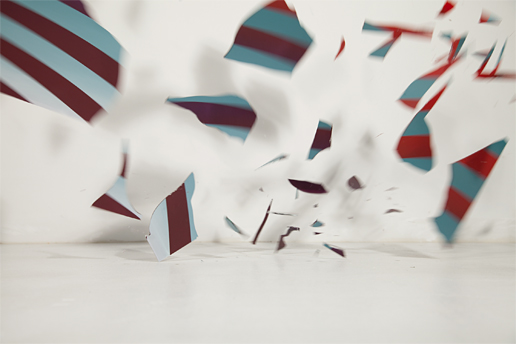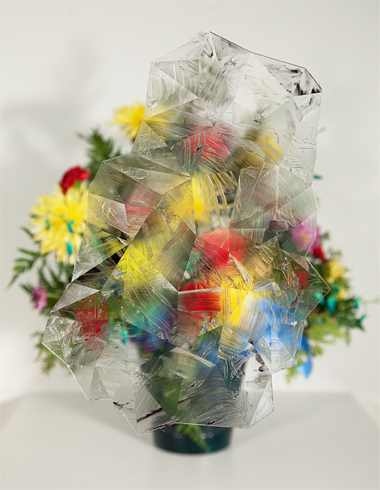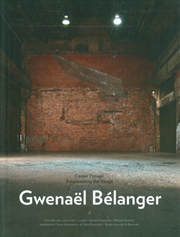A series of “Comic Strip (orange)” (2011) inkjet print. Image courtesy of the artist and Galerie Graff. © 2011 Gwenaël Bélanger
Canadian artist Gwenaël Bélanger works in close, critical observation of phenomena which lie at the limit of perception for the naked eye, but are enhanced using mainly photographic and other lens-based processes. In creating tension between what audiences see and expect to see, Bélanger finds his creative arena, where perceptive deceptions, constructions and manipulations flourish.
M-KOS interviewed Bélanger in occurrence with “Broyer du Noir + Color Breakâ€, his latest solo exhibition at Galerie Graff in Montréal, which featured some of his latest experiments in photography, glass and colour, plus a few surprises.
M-KOS: Can you tell us if any specific event triggered you to produce this new series of works?
Gwenaël Bélanger: This is the first solo show I organized since being awarded the Pierre Ayot Prize. There’s no direct connection with the works I entered for that submission, but a specific sum in that prize was dedicated to the promotion a forthcoming exhibition, which is this one.
M: The mirrors you used here have rather irregular shapes, not rectangular?
GB: The mirrors are cut into pointy shapes, like the archetypical shape of explosions in comic books. I did five different explosion shapes with mirrors, a fairly simple play to double-up the perception of breakage, to explode the shape of the blast, which itself shatters into fragments. After an initial fall, I stuck the pieces back together, to drop them down again, and burst the shapes even more, until they disintegrates, until we’re no longer able to recognize the shape of the explosion or pick up the tiny little pieces.
M: Is this the first time that you painted on mirrors?
GB: It’s actually silk-screen printing, a medium I discovered during my bachelor degree. I really liked it, but I hadn’t used it since, just because other experiments with photography kept me busy. The desire to use silk-screen techniques came back to me when I was offered a silk-screen teaching job at UQAM. When I started taking pictures of mirrors thrown on the floor, I was curious to see what happens when the reflection explodes. Now when you print an image on the mirror before, it’s about what happens when the image explodes, and seeing the colors burst out from the glass. So what we see in the works here is the result of experiments of breaking silk-screen prints on glass, and also printing residues on paper.
M: Can you tell us more about the residues on paper?
GB: When I finish printing on glass plates or mirrors, what happens is, before washing the screens used to transfer an image on glass, I make a transfer on paper to drain the excess ink that is still in the screen. So we get colored squares on sheets of paper, often gradients, with playful effects of layering, transparency, and so on. I call them residue because the compositions on paper are just in-between states from the first to the final steps in this project. They just represent squares of color that I drop on paper, much like the glass that I drop on the ground.
“Broyer du Noir #2” (2011) inkjet print. Image courtesy of the artist and Galerie Graff. © 2011 Gwenaël Bélanger
M: There is obviously an element of chance in taking pictures of glass pieces that break when they fall, you’re never quite sure of the final result. Is there more efforts to control the compositions with the works on paper?
GB: I would say yes, sometimes I tried to layout the impressions so that some colors go together. But I’m not a painter, my rapport with color is ok, but it’s of a different order than a painter. Chance was still present, in how the ink colors would react with each other. But it’s like the broken glass, the color fragments are still interesting, in the same way with the paper redidus, there are still things to explore there.
M: As collection pieces or artfacts?
GB: The silk-screen residues and glass fragments both served to produce an image. After that process something always remains, sometimes there is nothing to do with what is left, but there is always a potential.
M: Using chance in your work, did that have anything to do with chance being the theme for the Montréal Bienniale, presently on now?
GB: I’ve been working with chance for a long time now, but no, the Biennale didn’t call me.
M: You already produced a similar series on video, is there also a video element in this series?
GB: No, video can easily work as a by-product of a photoshoot, but it wasn’t the case for this series. However, we video-documented the silk-screen printing process of this project.
“Untitled (flower)” (2011) inkjet print. Image courtesy of the artist and Galerie Graff. © 2011 Gwenaël Bélanger
M: And what is next after this show at Graff?
GB: I’m in discussions with Nettie Horn gallery in London for an exhibition project somewhere in 2012, but nothing is confirmed yet, and I won’t necessarily show this series either. I always work with self-imposed constrains. With this show at Graff, I added color as a new element to my image production experiments. But I often try new avenues like this piece with the flower pot, that’s another avenue that opens up to other possibilities: how color can be modulated through glass, which is stained by lubricating engine oil, and Vaseline. This piece functions around refraction, that’s another direction I could explore in the future, I don’t know yet.
–– Interviewd by Oli Sorenson
“Broyer du Noir + Color Breakâ€, a solo exhibition by Gwenaël Bélanger is currently showing at Galerie Graff until 18 June 2011, .
The opening at Graff also provided an opportunity to launch the catalog “Gwenael Bélanger – Casser L’imageâ€, produced jointly by the Musée Régional de Rimouski and Expression Centre in Saint-Hyacinthe, and supporting the similarly titled touring exhibition, curated by Yann Pocreau.
Galerie Graff
963, rue Rachel Est, Montréal (Québec), H2J 2J4
T: +1 (514) 526 2616
E: graff@videotron.ca
Opening hours: Wednesdays to Fridays 11h to 17h30
Saturdays: 12h to 17h
www.graff.ca
Gwenaël Bélanger was born 1975 in Rimouski, Québec. He graduated from Université du Québec à Montréal (BA, 2000 and MA, 2008). Recent Solo exhibitions include “Casser L’image” at Galerie d’Art Louise et Reuben-Cohen, Moncton, (2011) and Musée régional de Rimouski (2010); Olympiade culturelle Vancouver 2010; Casser l’image : d’Autres Fragments at Galerie Graff (2009). Recent group exhibitions include “Fracturing the Burning Glass : Between Mirror and Meaning” at the ICA, MECA, Portland (2010); “Catch Me!” at Kunsthaus Graz, Austria; “En verre, sous verre … et sans verre” MACM, Montréal; “The Hidden Land” at Nettie Horn, London. Bélanger is represented by Galerie Graff in Montréal and Nettie Horn in London, UK.





Very nice work! thank you for the interview.